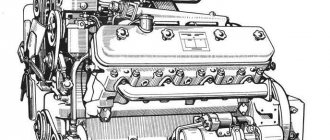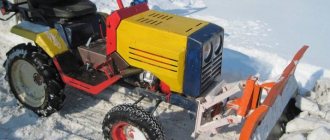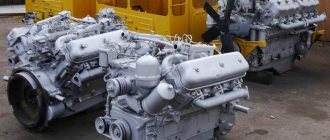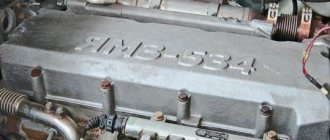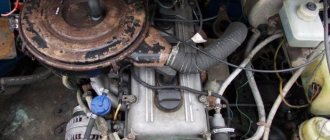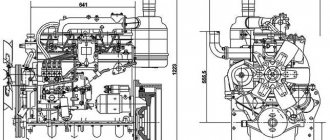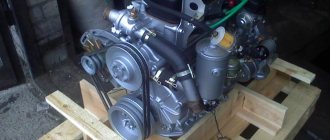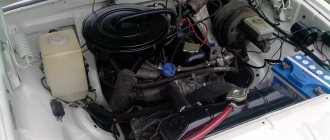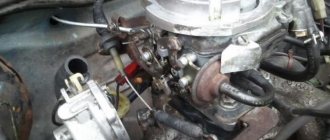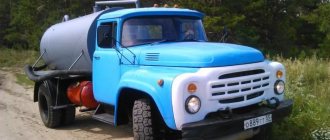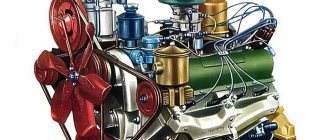Category: ENGINE
- The appearance of the motor
- Types of Gas 66 engines
- ZMZ-66
- ZMZ-513
- GAZ-544
- Technical characteristics of the Gas 66 engine
- Motor problems
- Motor maintenance
- Repair and tuning of the Gas 66 engine
The GAZ 66 truck, produced at the automobile plant in Nizhny Novgorod, is a mass product that powers the GAZ 66 engine of the same name. The period when the unit was made covers the time period from 64 to 99. During this time, they managed to develop three generations of vehicles with two axles, a 4x4 or 2x4 wheel arrangement and the ability to transport a load weighing two tons.
As for the power plant, the product was ordered from the Zavolzhsky Motor Plant, where the characteristics of the latter were calculated by both its own employees and GAZ employees. The product is named after the name of the car, however, the official marking is “ZMZ-513”. The motor was repeatedly modified and improved, and as a result, at that time the product was considered exemplary in its class. The unit is still relevant today, so production has not been discontinued.
GAZ-66:
The appearance of the motor
Calculations for the car and power plant began at the turn of the fifties. Initially, the vehicle was intended for universal use, like an all-terrain vehicle. The military was primarily interested in the product; agriculture also needed such devices. It is no coincidence that the car was used by geologists, workers in the oil and forestry industries.
When creating the car, the GAZ 66 engine was also developed from scratch; the technical characteristics of the installation corresponded to the trends of that time, ahead of competitors. The creation of the unit was the responsibility of designers and engineers who took the work seriously, and as a result, the set conditions were met. The motor turned out to be simple, reliable, durable, and the product was repaired in the field.
The first cars rolled off the assembly line in 1962, and serial production of cars began in 1964. The "finest hour" of GAZ 66 came in 1967, when the Gorky - Vladivostok - Gorky run was organized. The vehicle easily covered the route, part of which was off-road (Ural, Siberia, Transbaikalia, Far East). Both the car and the engine passed the test with honor, without receiving any serious damage.
Production of the car continued until 1995; later the unit was replaced by the GAZ-3308, which replaced the modification. The improved ZMZ-513 power plant, used on the 66th, is still produced today. The product is used on other modifications of GAZ vehicles, including “3308”.
Motor "ZMZ-66":
Price of new and used GAZ 66
The GAZ 66 was discontinued in 1999, which is why there are relatively few of these models on the used car market. At the same time, a used truck can be purchased at a very reasonable price. The machine has unlimited capabilities in terms of cross-country ability, and, despite its advanced age, can be useful in a variety of industries. The costs of modifying it for further work will be minimal, but turning the GAZ 66 into a car for long trips in comfort will definitely not be possible.
The average cost of a running car is 100,000-400,000 rubles. Onboard modifications are estimated at 200,000-250,000 rubles (years of manufacture 1997-1999). Versions with KUNGs will cost more – from 350,000 rubles.
ZMZ-66
Initially, they used the basic model GAZ-66, which was labeled by the manufacturer as “ZMZ-66”. The power plant was produced at the Zavolzhsky plant; it is a carburetor engine with eight chambers, four strokes, water cooling and a “V” layout. The engine had a volume of 4.254 liters, developed 120 horses and 284 Nm of impulse. The chamber cross-section was 92mm, the displacer stroke was 80mm. With these values, the compression was at 6.7, the weight of the unit was 262 kg. Together with the design, a carburetor of the K-126 model was used, later the product was replaced by the K-135. The engine was powered by A-76 gasoline, fuel consumption was 25 liters per hundred. To operate in sub-zero temperatures, a start-up heater was installed.
Engine D 245 9
Now let’s look in a little more detail at the features of the D-245.9 engine, since this model is more common. And home craftsmen often modernize the “Shishiga” with this power unit.
Diesel D-245.9 is a 4-cylinder internal combustion engine, with an in-line arrangement of cylinders, a 4-stroke operating cycle and compression ignition of the air-fuel mixture. The engine is started by rotating the crankshaft, which is transmitted from the electric starter to the shaft by the flywheel.
Diesel fuel is injected in a finely atomized state at the very end of the compression stroke, as a result of which the combustible mixture ignites and the piston moves downward, being under pressure due to the expansion of the combustion products of the air-fuel mixture.
For more economical and practical use of fuel, the nozzles through which diesel fuel is injected into the cylinder are equipped with high-speed magnetic valves. This approach became possible due to the introduction of electronic engine control.
This is what the D-245.9 diesel engine looks like.
A car (or other vehicle) is set in motion by transferring energy from the flywheel through the clutch to the transmission, etc.
If the requirements for compliance with Euro standards are met, an exhaust gas recirculation system (EGR - exaust gas recirculation) is included in the engine layout. In this case, part of the exhaust is returned to the cylinder, where nitrogen oxides are “afterburned” to inert N2O. A particulate filter with an oxidizer-neutralizer is also installed.
Description and operation
The main part of the engine body is the cylinder block. Removable liners are installed in the bores of the cylinder block, which are divided according to the internal diameter into three size groups: large (B), medium (C) and small (M).
diesel cylinder block D 245.9
Washing the cavity between the wall of the cylinder block and the liners with a cooling agent removes excess heat. The pistons are made of aluminum alloy. Two compression rings and one oil scraper ring are used.
ZMZ-513
In the early 90s, the GAZ-66 engine (“ZMZ-66”) was replaced with the “ZMZ-513”. This is a four-stroke power plant with a “V” layout, running on gasoline with the formation of a mixture by a carburetor. The motor is liquid cooled and assembled at the same Zavolzhsky plant. The design of the engine is successful, which is why the product is still produced today. Structurally, the unit is similar to its predecessor, but there are differences. The device is more compact, the block and head are made of aluminum, the volume has not changed (4.254 liters). The product develops 125 horses, impulse 284 Nm, compression 7.6.
Motor "ZMZ-513":
How to identify a malfunction?
Regardless of the engine modification, each power unit has a number of identical faults that the car owner may encounter. The most common include:
- Engine oil leaks through the oil seal, which is located in the rear main bearing.
- Reduced engine oil pressure.
- Increased engine oil or fuel consumption.
The presence of a breakdown can be determined by the condition of the engine. The malfunction will also be indicated by control indicators located on the dashboard. With their help, you can find out about violations of pressure indicators in the lubrication system.
It is worth noting that operating the car in cases where there is not enough pressure is prohibited. Otherwise, engine breakdown and failure of entire systems and structural components of the vehicle may occur.
GAZ-544
In addition to the engines listed above, an attempt was made to switch to diesel units. So, in the 90s, a small batch of GAZ-544 diesel engines was installed on the car. The power of the product is 85 horses, the impulse is 235 Nm. A small series of these engines with a turbine (116 horses) was also used, which received the index “GAZ-5441”. A distinctive feature of the installations is economical fuel consumption (17 liters per hundred), increased service life and productivity. However, the engines did not take root, and the main modification remained “ZMZ-513”.
Motor problems
As already mentioned, the power plant was structurally and technically reliable, durable and simple. The operational characteristics of the GAZ 66, such as engine power, impulse, etc., are sufficient to complete the tasks assigned to the vehicle.
The disadvantages of the product include the difficulty of starting a hot engine. A distinctive feature of the procedure is the tilt of the product at the time of the manipulation; a car standing on a slope does not want to start. For successful launch, press the gas pedal all the way. On a flat surface things are simpler, but not without complications.
A cold engine also has quirks; after some time after starting, the unit stalls, and at idle it shows instability. During operation, the motor does not like braking without disabling the gear. Such actions are accompanied by popping noises in the muffler and increased fuel consumption.
When symptoms appear, the parts of the ignition group (spark plugs, conductors, etc.) are checked. If the cause is not found, the problem is created by the spider. The part is sucking air and needs to replace the sealing element. If the repair does not bring results, the product is replaced. Replacement solves the problem, the motor works without failures.
Device
GAZ 66 was based on a frame structure. The model was produced in rear-wheel drive and all-wheel drive versions. The latter variation has become much more widespread. A reliable frame made of high-strength steel made it possible to install 2 drive axles, an engine with a transmission, a large operator’s cabin and a variety of bodies.
The front and rear suspensions of the car were dependent and had a similar structure. They were mounted on longitudinal semi-elliptical springs with telescopic hydraulic shock absorbers. Thanks to this, the model had a smooth ride. However, the presence of self-locking differentials in the main gears and single springs at the rear affected the strength of the structure. It was extremely undesirable to overload the GAZ 66.
The truck had an important feature - a balanced center of gravity with compact dimensions. The load on the rear and front axles was almost the same. This advantage allowed the vehicle to descend on all wheels without blocking the operator's cabin.
The GAZ 66 was equipped with a mechanical 4-speed transmission with synchronization in 3rd and 4th gears. It consisted of a single hypoid final drive, a single-disc hydraulic clutch and a 2-speed transfer gearbox. The location of the transmission was quite unusual. They were located to the right and behind the driver's seat, so driving a car required certain skills and seemed inconvenient for beginners.
The truck was again equipped with a transfer gearbox, used to enhance torque and distribute it between the front and rear axles. It provided the ability to turn on and off the front drive axle. Structurally, the transfer case included an intermediate shaft and a drive shaft with a movable gear for connecting reduction and direct transmission.
The brake system consisted of drum mechanisms with a diameter of 380 mm, a two-line pneumatic outlet for trailer brakes and a dual-circuit hydraulic drive with separation along the axles and a hydraulic vacuum booster in each circuit, which increases operating efficiency. The parking brake (drum, transmission) was mounted on the transfer case and equipped with a mechanical drive. Each circuit of the main brake system acted as a spare brake.
The GAZ 66 was equipped with 18-inch tires in the basic version. Later versions received air pressure adjustment. The car used disc wheels with a split rim and 6-stud fastening.
The steering was represented by a globoidal worm with a three-ridge roller and a spaced hydraulic booster.
GAZ 66 was equipped with standard electrical equipment with a voltage of 12 V. It included a 6-ST66-EM battery, a G287 generator and other elements.
Most modifications of the GAZ 66 were equipped with a winch, driven by a power take-off through an intermediate connecting support and 2 cardan shafts. Its parameters were superior to the electrical design. Its advantages were especially evident when traveling in difficult weather and road conditions. The winch's traction load was 3.5 tons. It was distinguished by its simplicity of design, thanks to which there were practically no breakdowns. The winch was allowed to be used in dirty and wet environments. Additionally, it was equipped with a brake.
The car was equipped with an all-metal 2-seater operator's cabin, which was mounted above the power plant. Unlike its predecessors, the GAZ 66 received a windshield washer and a heating system, which significantly increased operating comfort. Additionally, a hanging sleeping place (hammock, which was attached to four hooks) was installed in the cabin, allowing you to rest during long transportation. The interior space of the operator's cabin was distinguished by its laconicism. The salon could not be called large, but it allowed the driver and passenger to sit comfortably. The operator's cabin itself had a number of noticeable shortcomings. The car's hood became very hot, transferring some of the heat inside. In winter, this feature was very useful, but in summer it reduced the degree of comfort.
The GAZ 66 interior was borrowed from previous models with minimal changes. The driver's seat is adjustable for backrest angle and length. Passengers did not have such amenities. again there are places for attaching seat belts. To inspect the engine, the operator's cabin was tilted forward; between the driver and passenger seats there was a non-removable casing that covered the unit, so the transmission lever was located in an unusual place (behind and to the right of the driver).
The basic version of the GAZ 66 was quite multifunctional. A standard large metal platform was used as the body. There were benches on the sides for transporting people. The body had one folding side (rear), front and side removable grilles and specialized places for attaching arches. A classic awning was used to protect from precipitation.
Motor maintenance
For normal operation of the unit, the regulations provide for a number of manipulations, which include:
- Changing the working oil in the engine (15,000 km);
- Replacing the oil filter element of the installation (15,000 km);
- Valve adjustment (30,000 km);
- Replacement of the air filter element (25,000 km);
- Checking and replacing spark plugs (20,000 km);
- Monitoring the condition of the gas distribution mechanism (30,000 km).
Carrying out the above manipulations is the key to maintaining the initial characteristics of the motor at the proper level for as long as possible.
Oil filter for ZMZ-513:
Tuning
Despite the fact that the ZMZ 66 engine has long been out of production, car enthusiasts do not give up trying to improve it. True, it is not possible to use chip tuning in this case, since this motor is controlled without an electronic control unit (ECU).
In general, you can improve the performance of the ZMZ-66 power unit in several ways:
- Adjust the engine for the installation of modern gas distribution mechanisms.
- Replace the carburetor fuel supply system with an injection system.
- Install a turbocharging system.
These methods will increase the power and efficiency of the old engine, but will require a lot of time and high material costs.
There is another method, which in terms of labor costs and financial investments is akin to carrying out a major overhaul of the engine. The essence of the modification is to turn the ZMZ-66 power unit into the PAZ ZMZ 523 engine.
To do this you need to purchase and install:
- new crankshaft PAZ-3205 with liners ZMZ-5234;
- cylinder-piston group assembly, for example, the “Motordetal Kostroma” kit;
- set of gaskets and seals.
In addition, it is necessary to increase the compression ratio to 8.5. This can be achieved by trimming the cylinder head by 1.8 mm. It is not recommended to trim any more, as it will make it more difficult to install the intake manifold onto the cylinder head studs.
Car enthusiasts who have already carried out similar modifications also recommend replacing the standard K-135 (K-126) carburetor with an American Edelbrock 1407. This can be done by modifying the inlet manifold, combining its channels into one and welding the platform on which the new carburetor will be installed.
